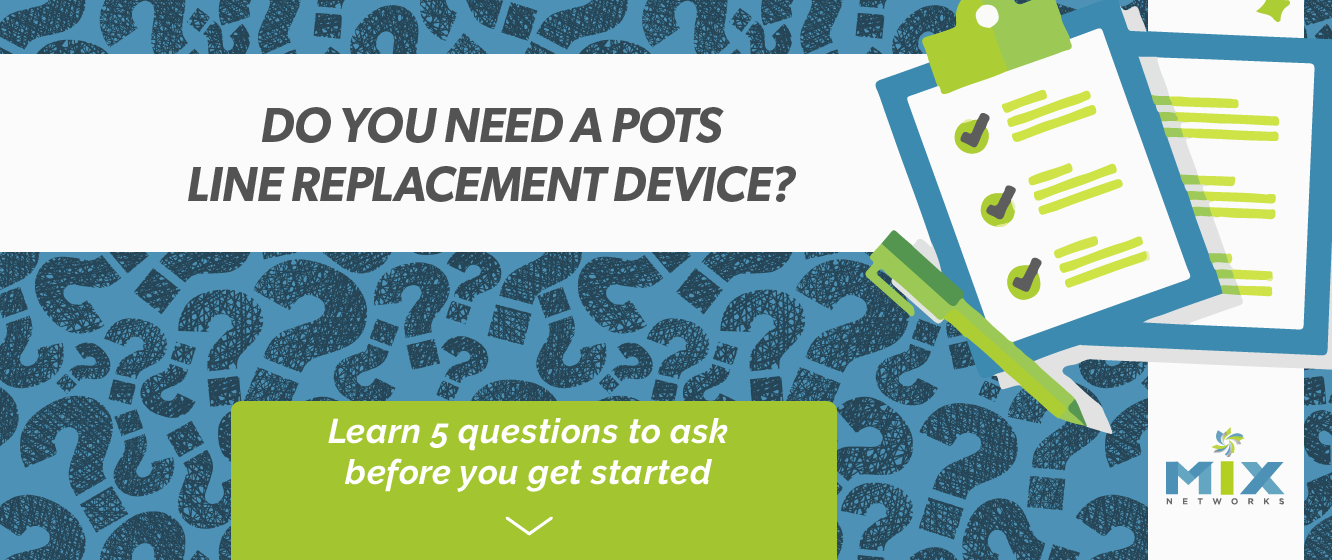In the telephony world, acronyms are tossed around like popcorn. POTS. PSTN. VoIP. M2M. IoT. SIP. UCaaS.
You may have already seen some of these as you’ve looked into new communications solutions for your business, but we thought we would take some time to clarify a key difference between POTS (analog) solutions and VoIP (Digital) solutions.
What are POTS Lines in Telecom?
No, POTS lines do not serve up coffee or boil your water. Short for Plain Old Technology Service, POTS refers to the analog twisted copper wires that have serviced our telecommunications since inception. POTS lines in telecom carry voice and data efficiently and reliably from point a to point b and with minimal disruptions. In fact, the telecom POTS lines originally carried telegraph communications and the telephone was created to use these same lines to deliver the voice.
The “official” definition of POTS can be found here and states “Plain old telephone service (POTS), or plain ordinary telephone system,[1] is a retronym for voice-grade telephone service employing analog signal transmission over copper loops. POTS was the standard service offering from telephone companies from 1876 until 1988[2] in the United States when the Integrated Services Digital Network (ISDN) Basic Rate Interface (BRI) was introduced, followed by cellular telephone systems, and voice over IP (VoIP).”
POTS lines transmit sound from point A to B by converting sound waves into electrical waves before being converted back to sound waves at the receiver’s device. The seemingly complex process happens almost simultaneously, making it feel like you are simply across the room, not across the world. The only reason POTS lines have held on as long as they have was the superior sound quality and reliability of the network.
What is VoIP?
The other side of the telecom technology is VoIP (Voice Over Internet Protocol). According to Wikipedia, VoIP “is a method and group of technologies for the delivery of voice communications and multimedia sessions over Internet Protocol (IP) networks, such as the Internet. The terms Internet telephony, broadband telephony, and broadband phone service specifically refer to the provisioning of communications services (voice, fax, SMS, voice-messaging) over the Internet, rather than via the public switched telephone network (PSTN), also known as plain old telephone service (POTS).” Businesses initially began migrating in the 1990s in an effort to save money, especially on long-distance costs. But the quality of service was still subpar. POTS copper wires were not capable of sending both sound and data simultaneously, causing congestion and choppy audio.
With the invention of broadband, however, the game changed. Broadband was built to transfer data, not sound, and was just what VoIP needed to gain the upper hand. Because broadband is “always-on” it was somewhat reliable, but not near to the level of POTS lines.
But soon, thanks to new offerings like Skype, VoIP started to become mainstream. And in 2004, the FCC determined that VoIP was not a telephonic offering but an informational service, meaning it was not subject to the taxes and fees that a typical POTS line was and did not fall under state and government regulations. As a result, VoIP was able to set competitive pricing that soon resulted in a mass migration from POTS to VoIP.
POTS Lines are Out, Long Live VoIP
Pretty soon, accessing a POTS line at all will be very difficult, if possible at all. In 2019, the FCC issued order 19-72A1, which released telecom carriers from the burden of maintaining the old and aging copper wires and effectively put the proverbial nail in the coffin. As copper lines began to disintegrate, telcos began to migrate users from the analog technology after a copper wire broke. Such was the case in Fire Island in 2012 after Hurricane Sandy ravaged the area and the local provider refused to install new copper to the island, instead opting for fiber optic or wireless delivery. And this won’t be the last time something like this occurs. Businesses across the country are receiving notice of either a significant increase in their per month fees for POTS lines and encouraging them to switch or simply being informed the POTS line will be decommissioned and they need to come up with a new plan.
Is your business at risk for disruption by the closure of the POTS lines of the PSTN? Download this free checklist to find out.
Keep Reading:









One thought on “What is the Difference Between POTS Lines and VOIP?”
Thisnis great!